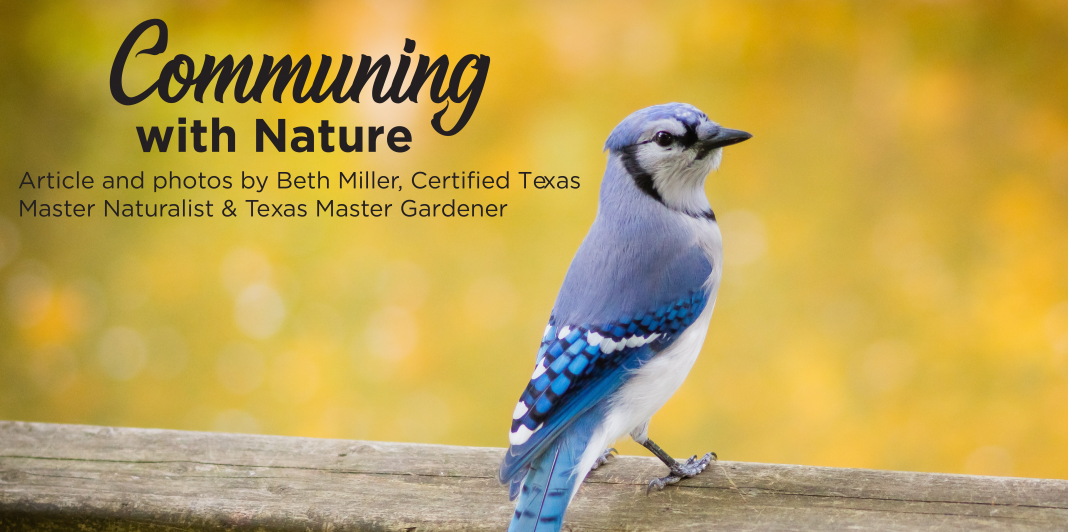Breeding Birds: Till Death Do Them Part, Sometimes
If you’ve braved the heat even for a walk around your yard or block, you’ve seen or heard bird couples feverishly trying to teach their newly fledged kids to feed themselves. Between early May and mid-July bird species pair off, many for life, find or build suitable nests and have babies.
There is no village raising these baby cardinals, blue jays, and other songbirds, just their parents, or for hummingbirds, just Mom. This month’s article features the mating status and parenting habits of the most common song and water birds we see every day.
Blue Jays: Look for their cup-shaped nests made of twigs and bark in the fork of a coniferous or deciduous tree branch, about 10-15 feet high. Following an elaborate and competitive courtship, the new couple mates for life and shares in the nest building and parenting duties, including incubating the 3 to 7 green-blue eggs. Both mom and dad actively hunt insects, seeds, nuts, and even small vertebrates for nestlings and once their kids begin to fly, they teach them to find their own foods, especially at feeders.
Red-headed Woodpeckers: These fun-loving, robin-sized birds seek out existing cavities or the tops of dead trees for nests. If needed, the male excavates the nesting hole with a bit of help from mom. Once the eggs are laid and hatch, both parents take turns incubating and feeding the hatchlings. Mom and Dad rustle up meals of insects, larvae, and berries, and enjoy mealworm suet or bark butter. Most woodpeckers are attentive parents, always close at fledging (flying) time and first trips to feeders.
House Finches: These little fun-to-watch birds are monogamous but only for one breeding season and maybe through that winter. The birds build nests of twigs, grass, and other plant materials in trees, but may favor the available basket, box, soft rag, or even a door wreath, giving us a front row seat to the nursery. Mom does most of the incubating as dad keeps her fed. After hatching, both parents share in the feeding duties, bringing a combination of seeds, berries, and insects to the nestlings, and then guide them to feeders and other hunting sources.
Eastern Bluebirds: These beautiful local residents build their nests in tree holes and are easily drawn to artificial nest boxes provided they meet very specific dimensions. The breeding pair often mates for life and will raise up to three broods in a season. Some bluebirds prefer to switch after rearing one brood to another partner. The pair selects a breeding site and builds their nest together, then mom incubates the eggs, while dad fetches insects and other small invertebrates to keep her strong. After hatching, both parents contribute to feeding and parenting the nestlings.
Northern Cardinals: East Texas’ forest lands are a cardinal hotspot year-round. Spring courtships often last for life. Look sharply for their cup-shaped nests made of twigs, leaves, and lined with soft grass, securely built in trees, vines, or dense shrubs 3 to 20 feet up. Both actively build the nest, often a 10-day process, then dad fetches food for mom as she incubates 2 to 3 grayish green eggs. Once hatched, both parents hustle to keep the nestlings fed with seeds, fruits, and insects.
Great Herons and Egrets: These graceful water birds don’t typically share nesting duties. Dad sticks around to get things started by bringing nest materials to Mom, in large nesting rookeries, with 10 to 100 other couples, in the tops of deciduous trees or large shrubs. These rookeries are often shared with cormorants, and at Smith Rookery on High Island, roseate spoonbills. Mom takes over to incubate the eggs, and dad provides food for her and helps feed the nestlings once hatched. The parents hunt for fish, amphibians, insects, and other small prey, regurgitated for the young.
Hummingbirds: These tiny jewels are not monogamous. Dad’s role is primarily courtship displays, defending territory, and competing for mates. Mom does all the heavy lifting with nest construction, incubation, and care of the young. She camouflages her tiny cup-shaped nest made of twigs, moss, and lichens to blend with the surrounding vegetation. Then lays her eggs and incubates them alone, maintaining the nest and ensuring the eggs are warm and safe. Dad may show up with a meal as mom is on the nest. She’s still there for the hatchlings, feeding them regurgitated nectar and small insects, as she protects them from potential threats.
Fledging, first flight, for most birds doesn’t occur until they are feathered and full size. Even eagles have to grow to full size before they can fly.
Keep your feeders full this time of year for adults and fledglings. Mealtime is fun watching time. Raw peanuts in the shell, safflower, black oil sunflower seeds and white millet are all good food sources.
Learn more about the birds in East Texas by joining a chapter of the Texas Master Naturalist or Texas Master Gardeners. To find a chapter close to you, or to read about the state programs, visit txmn.org or txmg.org. Volunteer and get involved!















